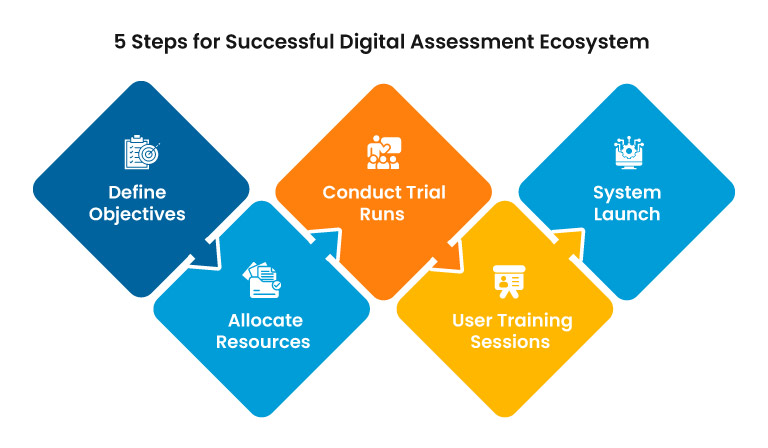Student Assessment Excellence: A Roadmap to Successful Implementation
In the realm of student assessment, the longstanding tradition of conventional evaluations has been an integral aspect of the educational landscape. Both educators and students have become accustomed to these customary assessment methods. Nevertheless, in the dynamic domains of science and technology, longevity is a rarity, with newer and superior ideas continually replacing the old.
The recent strides in Information and Communication Technology (ICT), exemplifying the progress in science and technology, have introduced a noteworthy concept termed “Digital Assessments.” While the concept is commendable, its successful integration into educational institutions and examination frameworks is imperative for optimal results. The adaptability of smart student assessment methods becomes pivotal in this technological progression.
In this article, we will have an in-depth discussion into the implementation of smart student assessment.
This is the third installment of our “Smart Assessment” series, check out the previous parts to decode the modern digital assessment pathways:
Establishing a Digital Assessment System: A Comprehensive Guide

Embarking on the journey of implementing a digital assessment system involves a meticulous approach. To ensure the efficacy of the system and avoid unnecessary expenditures, several key steps should be followed:
- Define Objectives: Begin by identifying the specific aims and strengths of your institution. This initial step is crucial to align the digital assessment system with your institution’s needs. Address prevalent challenges by consulting with personnel during the examination of answer sheets.
- Allocate Resources: Once objectives are established, consider the resources required for the digital assessment system. Digital scanners, high-speed computer systems, learning management software, AI-powered tools, and other technologies are essential components. Evaluate tools based on budget constraints and institutional requirements.
- Conduct Trial Runs: Prior to full implementation of smart assessment, conduct practice tests with a limited group of students. Evaluate the system’s onscreen suggestions and grading capabilities. Perform a comprehensive examination of software and hardware, particularly if using Optical Mark Reading (OMR). Repeat trial runs to identify and eliminate any issues, ensuring a seamless and error-free system.
- User Training Session: Facilitate a training session for staff to familiarize them with the digital assessment system and its advantages. This step empowers individuals with the confidence and expertise needed to navigate and utilize the system effectively.
- System Launch: After successful trial sessions and thorough teacher training, launch the digital assessment system. Monitor its functionality continuously and conduct regular assessments to ensure it remains up to date. Implement contingency plans in case of system failure, allowing for uninterrupted operations until issues are resolved.
In conclusion, the implementation of smart assessment methods demand strategic planning and execution. By following these steps, institutions can seamlessly transition to innovative assessment methods, reaping the benefits of a streamlined and efficient evaluation process. Now that we have grasped the procedure, let’s delve into crucial factors to consider.
Optimizing Student Assessment: Top 3 Considerations
- Start Gradually with Digital Assessment
Initiate your digital assessment journey with caution. Begin by introducing one or two digital tasks, progressively expanding to avoid complications. Consider the students’ comfort, acknowledging potential initial uncertainties. Initial resistance is common, requiring patience. Begin with simple, low-stakes digital assignments, allowing students to explore and learn without pressure.
- Empower Educators with Essential Tools and Training
Ensure educators are well-equipped for the transition to digital assessment. Provide access to user-friendly platforms with features like automatic grading and instant feedback. Training is crucial; even the most user-friendly platform requires educator proficiency. Address technicalities and emphasize the shift from traditional to personalized, engaging, and inclusive assessments.
- Diversify Assessment Methods
Digitally Embrace a variety of digital assessment methods to accommodate diverse learning styles. Move beyond simple multiple-choice quizzes; incorporate open-ended questions for critical thinking and multimedia tasks for visual or auditory learners. Explore adaptive assessments for accurate progress tracking, gamified assessments for engagement, and collaborative assessments to foster teamwork and critical evaluation skills.
Now, let’s explore an intriguing and innovative assessment method.
Möbius Student Assessment: Adaptive Questions
Meet Möbius, the revolutionary digital learning platform from DigitalEd India. It introduces the dynamic “Adaptive Questions” feature, guiding your students on a personalized path to success:
- Comprehension Assessment: Employing advanced algorithms, our student assessment system goes beyond mere evaluation, intelligently delving into the intricacies of individual comprehension levels. This innovative assessment approach discerns the nuances of knowledge gaps and proficiencies
- Adaptive Learning Paths: Craft a unique and personalized educational journey by dynamically adjusting question paths based on the real-time analysis of student performance and responses. Our digital assessment platform ensures a tailored experience, fostering an adaptive environment that meets students where they are.
- Innovation Integration: Redefining the landscape of student assessment, we introduce pedagogical innovation by incorporating simplified question versions, detailed step-by-step guides, and other instructional pathways. This multifaceted approach not only evaluates student knowledge but also actively supports and enhances their understanding.
Want to dive deeper and explore the Möbius experience?